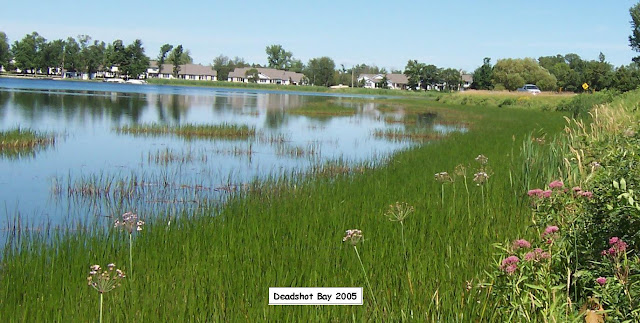The
sand bar separating Little and Big Detroit lakes has become a gathering place
for many Lake Detroiters and others. It
also serves as an important boundary between two different types of lake
situations – one large and deep, the other smaller and shallow; and it
figures in the two basins’ water quality differences too (a situation which I
have described elsewhere).
Early descriptions of the lakes from the late 1800’s depict the sandbar as a more prominent physical boundary between the lakes than it is today. Overall the water depth over the bar was much less then, and the dry points on either end were much closer to each other. Indeed, there were at least some periods when it was possible to walk across the lake without getting wet feet.
Such
walks no longer are possible, even during prolonged dry periods. Starting in the 1888 Detroit’s water levels
were raised by a series of dams by the Pelican River Navigation Company. I don’t know the amount of the water level
increase, but some indicate that the rise could have been between one and three
feet.
I
also have observed that lake levels were moved higher between 1965 and 1985 due
to manipulations of the Dunton Locks dam.
And since the early 1990’s precipitation has helped keep water levels high
too.
Another
factor contributing to a diminished prominence of the sandbar is erosion. It is quite likely that higher water levels
have contributed to spreading of sandbar material into both Big and Little
Detroit basins.
From
the early days a channel has been cut through the sandbar to facilitate boat
traffic between Big and Little Detroit.
The steamships which travelled between the East shore of Big Detroit
through Little Detroit, and down the Pelican River to Shoreham and beyond,
required a water depth of at least two feet, so in 1888 the first channel was
excavated.
The
early channel was dug (and subsequently kept open) with the help of horses and
mules. In most years it provided less
than three feet of depth, and even as late as the early 1950’s, there are those
who insist that children walked across the lake on the sandbar, and that the
depth of the channel was only “about up to our waists” – so say the informants.
In those days the channel was marked by
a few tamarac or cedar stakes; at some point in the late 1940’s, a single light
was added to assist night-time boaters in finding safe passage.
But
after 1945 boats and motors grew in size, and the old channel became
insufficient. There was talk about
enlarging and deepening the channel, much of it by Lake Detroiters and another
local organization, the “Inland Lakes Boat Club”. In the winter of 1953/54 a major dredging
operation was mounted, as described in
this article from the Lake Detroiters 1954 Annual Report. (Note the “ membership dues” referred to were
from Lake Detroiters’ members.)
The
sandbar’s “island” was created from the dredge spoils at this time.
There
is some doubt that the six foot depth described in the article was actually achieved Boats continued to grow in size, weight, and
draft, and in the late 1970’s and early
80’s there were new pressures to widen,
deepen, and lengthen the channel. This
time the Pelican River Watershed District was called upon to undertake a
project to fix the channel (and to do some dredging in the Pelican River between
Sallie and Melissa too). The project
was greatly complicated by regulations that prohibited disposal of dredged
material spoils in the lake. In the end
this excavated materials from the channel were carried by barges to the Highway
10 public access where they were hauled away for disposal. The project extended over several seasons,
mainly because of contractor defaults; the channel as we know it today was finally
declared complete in June, 1984.
I
would welcome any additional information (especially pictures) readers can
supply on this topic.







